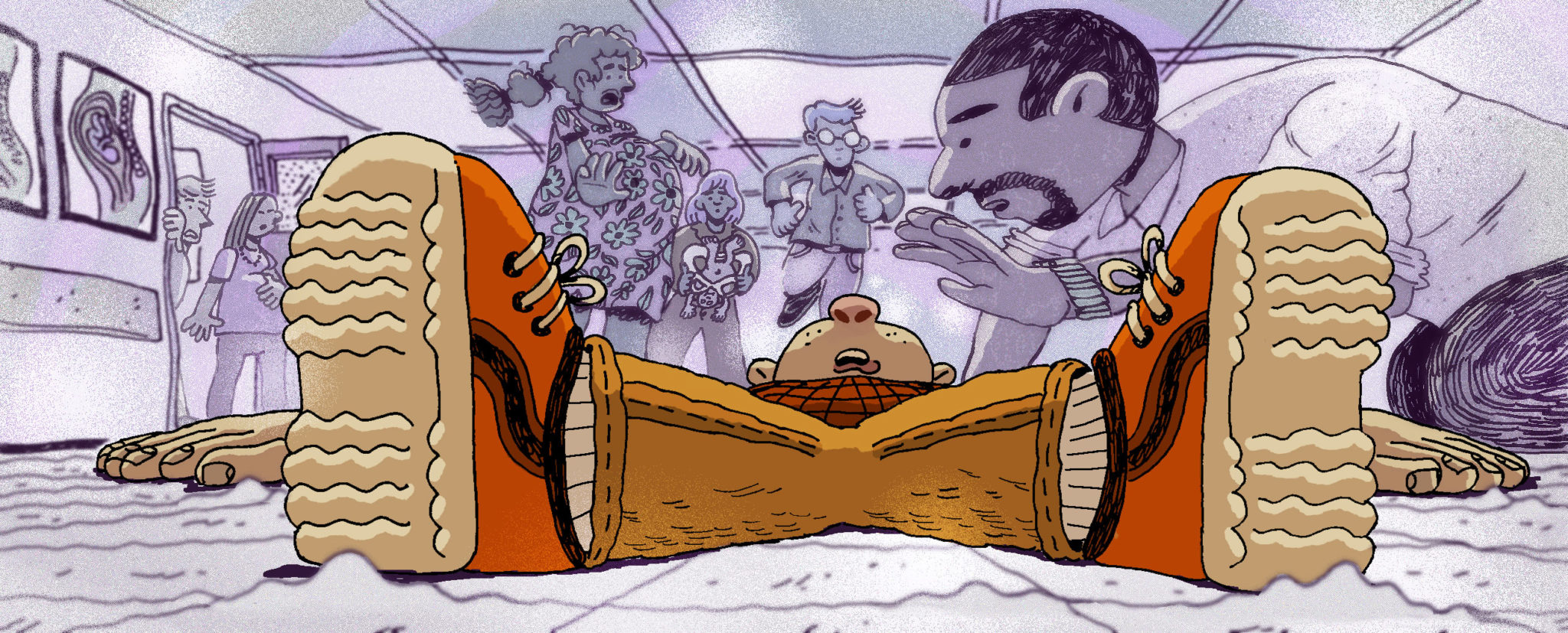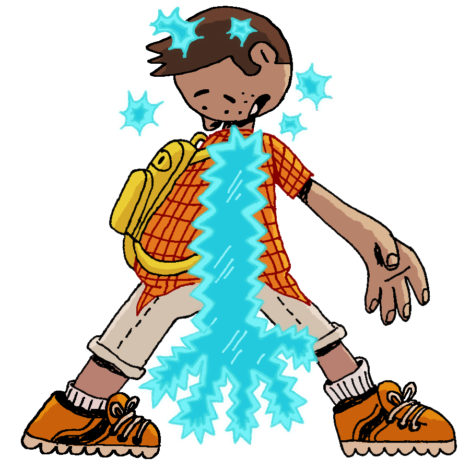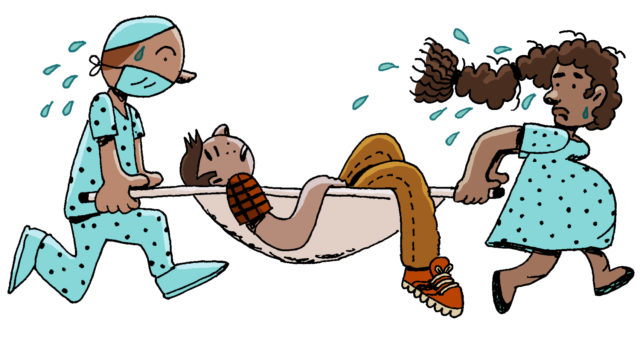
Illustrations by Franco Zacharzewski.
Kathy and I were getting serious. We’d talked about everything — we wanted to get married. We wanted children. But we hadn’t yet had “The Talk.” I was nervous, but I knew it was time to come clean.
I had to tell Kathy that I was … a fainter.
I’ve passed out enough times in my life that I don’t have an exact count. A few experiences stand out. When I was 10, my family went to Disney World. At Epcot Center, we saw the movie The Making of Me, which I now know was my parents’ way of teaching my brother and sister and me about the birds and the bees.
I don’t remember a lot about the video, just that it was family-friendly and did not show graphic sex. We were in Disney World, after all. In the movie, when the couple turned out the light in their bedroom, the camera panned to the roof, where our cartoon character host was waiting for us, ready to narrate the next scene, which involved a very pregnant lady and the trip to the hospital.
That’s where the images got graphic.
Yes, 10-year-old me saw a baby being born. I’ll never forget the blood. It was intense. To this day, my aversion to violent movies (and any blood on screen) dates back to witnessing that childbirth scene in The Making of Me.
The movie ended abruptly after that scene. My 12-year-old sister chatted away, oblivious to my distress as we walked into the lobby. I didn’t hear a word she said, as my ability to hear faded. I stopped to lean against a column as my sister walked on, still chatting, and then with a thump I slumped to the ground, unconscious.
My family tells me that the Disney medics swooped in as soon as I hit the floor. It was all so quick, I don’t even know if my younger brother, who was walking ahead of us, even knew anything was amiss. Everyone was remarkably calm. After determining that I didn’t need to go to a hospital, the medics dispersed. I regained consciousness with no side effects — except one. Now I dreaded the day I might have a child of my own.
* * *
Later, during a high school math class, the teacher showed us a video about real-world applications of ellipses. A guy in the video told a story about undergoing a laser procedure to remove his kidney stones. As he started covering the details of the unbearable pain, my hand shot up in the air. I had to leave the classroom. Quickly.
“Can I go to the bathroom?”
The teacher nodded, barely acknowledging me, because he was so captivated by the video.
As I walked down the hall, I heard a noise.
Thunk. Thunk.
“That’s weird,” I thought. “Where is that sound coming from?”
Thunk. Thunk. Thunkthunkthunkthunkthunk …
I looked to my left and didn’t see anything. Then I looked to my right and realized that the noise was coming from my shoulder as it banged against the row of lockers lining the hallway. This time, instead of having my hearing fade, I lost feeling in my arm. As a result, I didn’t feel the impact, but I heard every sound as I slowly fell to the ground. I knew I wasn’t making it to the bathroom. In fact, I was right by the main staircase on the second floor. Any minute the bell would ring and almost every student in my all-boys high school would be walking by me, as I lay there crumpled on the ground. “Great,” I thought. I wouldn’t be known for anything in high school except for being “the guy who fainted.”
As luck would have it, I collapsed outside of the science teacher’s classroom. He swooped in with smelling salts so fast it seemed like maybe a student passed out in front of his classroom every other day. Lucky for me, I regained consciousness and was sent home without anyone else in school even noticing.
Shortly after that incident, I passed out at breakfast. Just sat down and fell face-first into my bowl of oatmeal. Had it not been so scary, it might have been funny. But it was scary, because there was no precipitating event. My mother was the only other person in the room, and her high-pitched shout of “John!” was the last thing I heard before I slumped down at the table.
Instead of going to school that day, I went to see a cardiologist. That’s when I learned my condition had a name: vasovagal syncope.
When something upset me, my heart rate slowed down suddenly, and the lack of blood pumping to my brain caused me to black out. For some people, vasovagal syncope is a severe enough problem that it interferes with their quality of life. But the doctor told me that I had a healthy heart, so I thought of it as more of a minor inconvenience. The only real impact the diagnosis has had on my adult life is that every time I have to fill out a medical history checklist — at a new primary physician, the endodontist for a root canal, even at the eye doctor — I have to check the “fainting” box and explain my history.
Naming what was happening to me made it easier for my brother and sister to make fun of me. (When I’m around my family and we’re watching a grisly movie, or a medical segment on the news, inevitably someone will turn to me and jokingly say, “Vasovagal?” to see if I’ve been triggered.)

Gradually, I figured out that my fainting episodes were only caused by seeing or hearing about someone else go through something painful. It was like I had a superpower — I had a high tolerance for pain of my own, but my kryptonite was hearing about someone else’s painful episode.
But I also learned to take some control of the situation. Though no two occurrences were exactly alike, they all featured one consistent physical symptom: clamminess. Whether I ultimately lost hearing or the sensation in a limb before I went down, if I started sweating and seeing stars, I knew a fainting spell was on the way. And if I had my wits about me, I could stave off the episode. If I was able to lie down and elevate my legs (to get the blood rushing back to my head) or put my head down between my knees, I could potentially prevent myself from passing out.
I learned that I could overcome the symptoms. A turning point came in another high school class, watching another video. This time it was Spanish class, and for some reason the person in the video started talking about the pain (dolor!) he’d experienced as a burn victim. It came out of nowhere, so I had to act quickly. Ever since the ellipses video, I had been on high alert — anytime a teacher popped in a video, I ran through a quick mental checklist about anything in the content that might bring on a fainting episode.
The Spanish video featured none of the potential triggers (which would have probably only included childbirth or real-life applications of ellipses). The clamminess snuck up on me, and it was too late to leave the room and go to the bathroom (another ineffective strategy that I consistently used), but I did put my head down at my desk — the closest I could get to putting my head between my knees. The clamminess subsided and the stars cleared from my vision.
I now had a weapon to fight the condition.
I imagine the onset of a fainting episode is a lot like Bruce Banner turning into the Incredible Hulk, except instead of a transformation triggered by extreme anger over some kind of injustice, I probably just witnessed someone getting a boo-boo. Perhaps my fainting is more like the Incredible Hulk transforming back into Bruce Banner.
I’ve rarely heeded the clamminess warning throughout my life though. The episodes come on so gradually, I usually think I can just fight my way through. Then, before I know it, my legs are out from under me and I’m on the ground.
When Kathy and I were dating, I didn’t feel like I was keeping any secrets from her — but it was always in the back of my mind that I should probably advise her to elevate my legs if I ended up unconscious during one of our dates. But for the most part we steered clear of triggering events. After we eventually had “The Talk” (we couldn’t avoid the childbirth conversation forever), the story about how I fainted at Disney World was always good for a laugh, especially when my family was around to poke fun. After we got married, it was more of a cautionary tale, one that explained why I believed I was in danger of passing out in the delivery room. When Kathy became pregnant and signed us up for a childbirth class, during which I was sure the instructor would play a video of a live birth, I brought up the issue again. I didn’t think I could make it through the birth of my child without passing out.
“John,” Kathy admonished, “you’re not a teenager anymore.”
Kathy has always been supportive of me. That was one reason I was scared to take the childbirth class — I couldn’t stand the idea that I wouldn’t be able to be there to support her as our child entered the world. I also questioned my ability to be an effective father. Most of my 20-something male friends were weighing whether they were ready for marriage and commitment. They didn’t spend a lot of time thinking about parenthood. I was ready.
With the childbirth class imminent, though, the worry became tangible: If I couldn’t make it through childbirth, what chance did I have of being there for my child when he or she needed me as they grew and encountered the inevitable difficulties of life?
With the memory of the Disney movie in mind, Kathy and I worked out a code to use in class. I told Kathy I would squeeze her knee if I thought I might faint and I needed to leave the room. Still skeptical that “the vasovagal” would actually rear its head during such an important moment, she agreed to humor me.
Less than an hour into the class, the nurse stood in front of the room talking about how difficult childbirth could be. She picked up a doll and a model of a hip and started to illustrate the different ways that things could go wrong. She showed a breeched birth. She showed how rough things could be for the baby even if everything was going smoothly. She banged the doll’s head against both sides of the hip.
I squeezed Kathy’s knee.
You might think a childbirth class inside a hospital with a nurse present is a good place to pass out. That’s probably true. The problem was, after I squeezed Kathy’s knee, I abruptly left the room — a strategy that still hadn’t worked once in my life. But it was too late: I already knew I was going to pass out.
I stepped into the empty corridor. It was on the fifth floor of the hospital, in an area with a bunch of offices. But it was 9:45 a.m. on a Saturday, and there was no one there. I know, because I looked for help. I looked left. Nothing but a long hallway of empty offices. I looked right. Nothing but a window.
Kathy tells me that inside the classroom they heard two huge thumps, separated by about three seconds.

I remember those three seconds — although my hearing faded, so I didn’t hear the noise my body made after I hit the floor and then tried to pull myself up on a table before I passed out again. (Thump two.)
I came to with Kathy shouting my name in the hallway as three of the other dads in the class pressed cold compresses to my face and mouth, where I was bleeding. (Just our luck! The other dads were doctors.)
The nurse strongly suggested we go to the emergency room.
I explained to the emergency room folks that this had happened before. I threw around the medical term. They were unimpressed. I was embarrassed that I couldn’t make it through more than 45 minutes of childbirth class, and I dreaded the failures that lay ahead of me as a father.
But I also felt so validated! I smiled at my wife through my fat lip, and she knew she should have taken my condition more seriously.
* * *
I made it through our daughter’s birth OK. (So did my wife and the baby.) I kept myself busy in the delivery room, making sure that whatever music Kathy wanted was playing, and doing other important things like staying out of the way. Kathy’s sister was there to help out, and to make sure Kathy would have the support she needed if I passed out. But I didn’t faint — didn’t even come close. I did make sure that her sister stayed on the “business end,” while I was up near Kathy’s head. My body clearly understood the magnitude of the moment — the emotion surrounding the birth of our first child suppressed any desire to shut down. My heart was not going to slow down; if anything it was beating a mile a minute and filled with joy. I don’t think you need a cardiologist to tell you that’s also a sign of a healthy heart.
When we came home from the hospital with our little baby’s hospital tag and our maternity ward bracelets, we placed them next to my bracelet from the emergency room six weeks earlier.
I didn’t just make it through that birth without passing out — we’ve since had two more daughters, and I stayed conscious for their births too. We didn’t even need Kathy’s sister to come into the delivery room. I was sure I wouldn’t pass out — as long as I stayed up by Kathy’s shoulders and focused on her breathing. (Reports say I turned a little green during our youngest daughter’s birth, but that’s only because she arrived quickly and there was a nervous tension in the room.)
The joking hasn’t stopped though. Kathy has since attended the same childbirth class with her pregnant sister.
“I’m really excited to see what happens after the first 45 minutes,” she told me.
John Sucich is a writer and comedian living in Massachusetts. He hasn’t passed out in more than a decade.